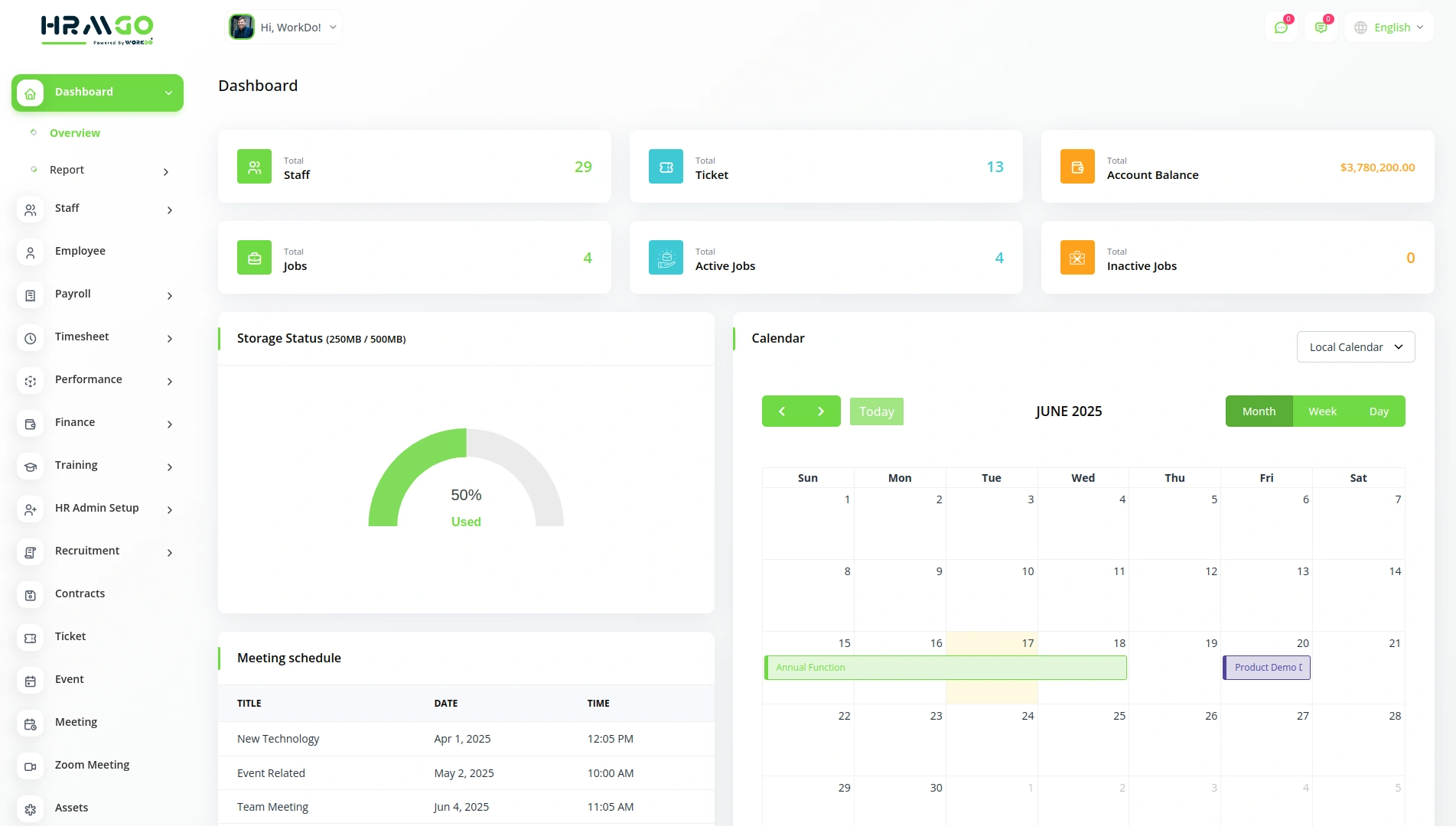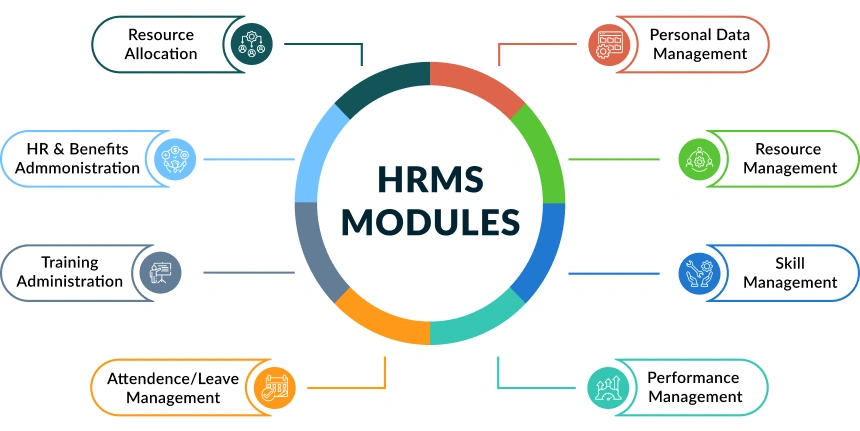A Complete Guide to HRMS (Human Resources Management System)
HRMS software helps manage human resources by automating and organizing tasks like payroll, attendance, leave management, and employee data. Learn what HRMS is, its definition, meaning, key features, modules, benefits, and how businesses use HRMS tools to streamline HR operations and improve workforce management.
- Introduction to HRMS
- What is HR? What is HRMS?
- HR Meaning in Office, Company, and Job
- Why is HR Important in Organizations?
- Definition and Concept of HRMS
- What is Human Resource Management (HRM)
- Definition of HRM & HRMS by Experts
- Key Features of an HRMS Software
- Modules of HRMS Explained
- Roles & Responsibilities of HR in HRMS Environment
- Types of HRMS Software
- Challenges in Human Resource Management and How HRMS Solves Them
- Best HRMS Software in India
- Conclusion
- Frequently Asked Questions
Introduction to HRMS
In today’s fast-paced and digitally connected business environment, managing employees efficiently is more critical than ever. Human Resource Management Systems (HRMS) help organizations streamline HR functions, reduce manual tasks, and enhance employee experience. Before diving into the capabilities of HRMS, let’s start with the basics.
HR Full Form, HRMS Full Form
- HR Full Form: Human Resources
- HRMS Full Form: Human Resource Management System
HR refers to the department or function in an organization responsible for managing the employee lifecycle — including hiring, onboarding, training, payroll, and compliance. An HRMS is the digital solution that Automatic these tasks, offering tools to simplify and optimize HR operations.
What is HR? What is HRMS?
What is HR?
Human Resources (HR) is a function within organizations that focuses on managing people — from recruitment to retirement. HR professionals handle tasks like workforce planning, payroll, employee relations, training, and maintaining workplace culture.
What is HRMS?
A Human Resource Management System (HRMS) is a cloud-based software platform that integrates all HR functions into one cohesive system. It reduces the dependency on manual processes and ensures data accuracy, compliance, and better decision-making.
HR Meaning in Office, Company, and Job
In the office: HR refers to the internal department responsible for employee well-being, workplace policies, and resolving conflicts.
In a company setting: HR manages strategic roles such as hiring, compliance with labor laws, organizational structure, and compensation planning.
In a job title: “HR” can refer to roles like HR Executive, HR Manager, or HR Business Partner — all of whom are tasked with supporting the company’s human capital and organizational goals.
Common HR job titles include:
- HR Executive
- HR Manager
- Talent Acquisition Specialist
- HR Generalist
- Learning and Development (L&D) Manager
- Compensation and Benefits Manager
Why is HR Important in Organizations?
Human Resources is not just an administrative department — it’s a strategic partner in business growth and sustainability. Here’s why HR is critical:
- Recruiting the Right Talent: HR ensures the company hires candidates who align with organizational goals and culture.
- Employee Retention & Engagement: Through performance reviews, benefits, and wellness programs, HR improves job satisfaction.
- Legal Compliance: HR keeps the company aligned with employment laws, preventing legal risks.
- Training & Development: HR plans learning programs to enhance employee skills and productivity.
- Payroll and Compensation: Ensures employees are paid accurately and on time with all legal deductions and benefits.
- Building Organizational Culture: HR helps shape a healthy work environment and values-based culture.
Definition and Concept of HRMS
HRMS stands for Human Resource Management System, a digital platform designed to streamline and automate HR functions within an organization. It brings together various human resource processes into a single, integrated system. This includes tasks like payroll processing, attendance tracking, leave management, recruitment, performance management, and employee record-keeping.
Traditionally, HR teams handled these processes manually, using spreadsheets and physical files. However, with growing businesses and changing work dynamics, especially post-COVID, manual methods are no longer efficient. An HRMS software provides a cloud-based, scalable, and secure solution that enables real-time tracking of HR activities, ensures legal compliance, and improves overall productivity.
Modern HRMS platforms — like Workdo.io — are built to serve both small businesses and large enterprises. These systems offer user-friendly dashboards, analytics, and employee self-service portals that empower both HR professionals and employees. An HRMS also helps reduce human error, supports remote work environments, and ensures faster processing of HR operations.
What is Human Resource Management (HRM)?
HRM Human Resource Management refers to the strategic management of people within an organization. It involves recruiting the right talent, training and developing them, managing their performance, and ensuring they stay motivated and productive. HRM is the foundation of a well-functioning organization, as it focuses on building a positive and productive workplace culture.
The core objective of HRM is to align the workforce with the organization’s short-term and long-term goals. This includes:
- Workforce planning and job analysis
- Hiring and onboarding
- Training and development
- Compensation and benefits
- Legal compliance and labor law adherence
- Employee engagement and retention
- Performance appraisals
By implementing HRM effectively, companies can maximize employee potential, increase job satisfaction, reduce turnover, and create a competitive advantage in their industry.
Definition of HRM & HRMS by Experts
To understand these terms in depth, here are definitions from industry experts and widely accepted HR literature.
Definition of HRM by Experts:
“Human Resource Management is the planning, organizing, directing and controlling of the procurement, development, compensation, integration, maintenance, and separation of human resources to the end that individual, organizational, and societal objectives are accomplished.”
This definition highlights the structured and goal-oriented approach of HRM, which ensures that every HR function serves both business and employee growth.
Definition of HRMS (General Industry View):
“An HRMS is a suite of software applications used to manage human resource and related processes throughout the employee lifecycle.”
This includes recruitment, onboarding, time and attendance, payroll, and performance management — all automated within a digital environment. By using an HRMS, businesses ensure accuracy, save time, and reduce operational costs.
Key Features of an HRMS Software
Modern businesses rely heavily on HRMS (Human Resource Management System) software to manage their people, automate routine HR tasks, and ensure organizational efficiency. A well-built HRMS goes beyond just managing employee data — it brings together payroll, performance, attendance, and employee engagement into a single digital ecosystem.
Here are the key features of an HRMS software that make it indispensable for HR departments, especially in growing organizations and SMEs:
Centralized Employee Data Management
One of the core functions of an HRMS is to serve as a centralized employee information system. It stores all critical employee data — such as personal details, job titles, joining dates, salary history, performance records, documents, and more — in a secure, organized format.
Benefits:
- Easy access to real-time data
- Reduces paperwork and manual errors
- Quick document retrieval during audits or appraisals
- Secure data storage with role-based access control
This centralized approach improves HR productivity and ensures better data accuracy across departments.
HRMS Payslip & Payroll Integration
A robust HRMS payroll module automates the entire salary process — from calculating earnings, deductions (PF, ESI, TDS), and taxes to generating HRMS payslips and Form-16 documents.
Features Include:
- Monthly payroll processing
- Automatic tax and compliance calculations
- Direct bank transfer integrations
- Payslip generation and download from HRMS portal
- Bonus, incentive, and arrears management
Integrated payroll saves time, ensures compliance with Indian labor laws, and improves employee trust with transparent salary processing.
Attendance & Leave Management System
Manual attendance tracking is outdated. An HRMS offers a real-time attendance management system, often integrated with biometric devices or mobile check-ins.
Key Features:
- Leave application and approval workflows
- Calendar view for tracking leaves and holidays
- Auto-calculated leave balances
- Integration with payroll to manage LOP (Loss of Pay)
- Mobile-based attendance marking
This helps HR teams monitor workforce attendance, reduce absenteeism, and automate leave policies as per company rules.
HRMS Portal Access for Employees
A modern HRMS includes a self-service portal that empowers employees to manage their own HR-related activities. This reduces the workload on HR staff and boosts employee satisfaction.
What Employees Can Do via HRMS Portal:
- View and download payslips
- Apply for leaves and check leave balance
- Mark attendance or request corrections
- Access documents like offer letters, ID cards, or HR policies
- Raise service requests or HR helpdesk tickets
Self-service features bring transparency, speed, and convenience to daily HR operations.
Performance Appraisal and Feedback Tools
A good HRMS includes a performance management module that allows continuous feedback, KPI tracking, and structured appraisals.
Features:
- Goal setting and performance tracking
- 360-degree feedback and peer reviews
- Quarterly and annual performance evaluations
- Custom rating and review templates
- Promotion and increment recommendations
By automating performance reviews, HR teams and managers can make data-driven decisions and foster a culture of continuous improvement.
Wellness and Employee Engagement Modules
HRMS platforms are increasingly integrating wellness and engagement tools to support mental health and improve employee morale.
Common Wellness Features:
- Stress management tips and surveys
- Mood tracking tools
- Anonymous feedback forms
- Recognition and rewards systems
- Employee pulse surveys and polls
These features promote a positive workplace culture, reduce burnout, and improve retention.
Modules of HRMS Explained
In today’s digital age, a comprehensive HRMS software is essential for managing human resources efficiently. An HRMS (Human Resource Management System) integrates various HR functions into modules that automate and streamline processes such as attendance, payroll, recruitment, and compliance. Below, we explain the key modules of HRMS and their significance for organizations, especially SMEs looking for scalable, cloud-based HR solutions.
HRMS Dashboard
The HRMS dashboard is the first point of interaction for HR managers and employees. It offers a centralized view of critical HR data, including attendance management system reports, leave summaries, payroll status, and upcoming employee events. This dashboard simplifies HR operations by consolidating data into easy-to-understand charts and alerts, empowering HR teams to monitor workflows and quickly address any pending tasks. Dashboards often feature customizable widgets, enabling users to focus on metrics relevant to their role, which improves HR functionality and decision-making.

Leave Management
The leave management module automates employee leave tracking and approvals, making it easier to manage different leave types such as casual, sick, maternity, and earned leaves. Employees can apply for leaves via the HRMS portal, and managers can approve or reject requests through automated workflows.
Integration with the attendance management system ensures accurate leave balance updates and helps in calculating salary deductions in the payroll. The module supports leave encashment policies and provides comprehensive leave reports, reducing paperwork and errors significantly. This makes leave management transparent and hassle-free, critical for maintaining employee satisfaction and productivity.
Payroll Processing
One of the most crucial components of any HRMS software in India is the payroll processing module. This feature automates salary calculations, including deductions like PF, ESI, and TDS, and generates accurate HRMS payslips. By integrating with attendance and leave data, it ensures precise payroll management without manual intervention.
The module supports statutory compliance with Indian labor laws, generates tax reports, and facilitates bank transfers, making salary processing efficient and timely. This automation saves HR teams countless hours and eliminates errors in payroll calculations, thus boosting employee trust and organizational transparency.
Recruitment & Onboarding
The recruitment and onboarding module simplifies hiring by digitizing the entire recruitment process — from job posting, resume screening, interview scheduling, to final selection. HR teams can track candidate status through an Applicant Tracking System (ATS), ensuring no application gets lost or overlooked.
Once a candidate is hired, the onboarding process is streamlined via digital document submission, training scheduling, and employee induction workflows. This module enhances the new hire experience and reduces time-to-productivity, making it an essential tool for fast-growing companies.
Employee Self-Service Portal
The Employee Self-Service (ESS) portal is a key feature that empowers employees to manage their own HR activities without constant HR intervention. Through this portal, employees can download payslips, update personal information, apply for leave, view attendance records, and access company policies.
ESS increases transparency and communication while freeing HR staff to focus on strategic initiatives. Many HRMS platforms provide mobile-friendly portals, enabling employees to stay connected on-the-go.
HR Help Desk and Support System
An efficient HR help desk system within HRMS software provides employees with a channel to raise queries related to payroll, leave, benefits, or grievances. This system tracks support tickets, assigns them to relevant HR personnel, and monitors resolution times.
Including a knowledge base with FAQs empowers employees to find quick answers independently, reducing repetitive HR queries and improving overall service delivery.
Compliance and Policy Management
Maintaining compliance with evolving labor laws and internal company policies is complex. The compliance and policy management module in HRMS helps automate document storage, policy dissemination, and employee acknowledgments.
It also sends automated reminders for statutory filings and tracks training completion related to workplace safety or legal requirements. This reduces legal risks and ensures companies remain audit-ready at all times.
Roles & Responsibilities of HR in HRMS Environment
In today’s digital workplace, the role of HR professionals has evolved significantly, especially within an HRMS environment. HR teams leverage HRMS software to automate routine tasks, improve data accuracy, and focus more on strategic functions like talent management and employee engagement.
Who is an HR Manager?
An HR Manager is a key professional responsible for managing an organization’s human resources. They oversee recruitment, employee relations, training, and compliance, ensuring alignment with company goals and labor laws. In an HRMS environment, HR managers utilize technology to streamline these processes and make data-driven decisions.
HR Manager Role and Responsibilities
The HR Manager’s role includes recruiting and onboarding talent, managing payroll and attendance via HRMS payroll software, handling performance appraisals, and ensuring employee welfare. They also maintain employee records, manage leave and attendance systems, and address employee grievances efficiently through HR portals.
Functions of HRM (Managerial & Operative)
HR functions split into managerial (planning, organizing, directing, controlling HR activities) and operative (day-to-day tasks like recruitment, payroll, training, and compliance). An HRMS helps automate operative functions, allowing managers to focus on strategic HRM.
Organizational Structure of HR Department
Typically, the HR department consists of HR Managers, recruiters, payroll specialists, and HR coordinators. The structure varies by company size but is unified through HRMS solutions to ensure seamless collaboration and data sharing.
Types of HRMS Software
Cloud-based HRMS
Cloud-based HRMS software offers flexibility, automatic updates, and remote access. It’s ideal for startups and large enterprises alike. Many prefer cloud solutions for their scalability.
On-premise HRMS
Installed locally, these HRMS solutions offer better control but require significant IT support. It’s suitable for companies with strict data privacy policies.
Open-source HRMS
Open HRMS systems allow customization and are cost-effective. Organizations with tech teams often opt for these for higher adaptability.
Challenges in Human Resource Management and How HRMS Solves Them
Major Challenges
Common challenges include:
- Managing remote teams
- Ensuring data security
- Maintaining compliance
- Recruitment and retention
HRMS as a Solution
HRMS tools tackle these challenges by:
- Centralizing data
- Offering role-based access
- Providing real-time alerts
- Streamlining hiring with recruitment HR modules
Best HRMS Software in India
Overview of Top Solutions
India’s top HRMS solutions are evaluated based on scalability, features, and ease of use. However, among them, Workdo.io stands out as a comprehensive and user-centric platform tailored for Indian businesses.
Why Workdo.io’s HRMS is a Top Pick
Workdo.io’s HRMS offers a robust suite that includes payroll & HR software, leave and attendance management, and employee details management. With features like performance appraisal in HRM, a clean HRMS dashboard, and seamless integration with other enterprise systems, Workdo.io remains a top choice. Its scalability suits both SMEs and large enterprises, making it one of the most versatile HRMS solutions in India.

Conclusion
A well-integrated Human Resources Management System (HRMS) is vital for every modern organization. It reduces administrative burden, ensures compliance, and enhances employee satisfaction. Whether you’re looking for HRMS software in India or exploring cloud-based HR software, choosing the right solution like Workdo.io can revolutionize your HR operations.
From understanding the full form of HR to exploring HRMS applications, this guide has covered the essentials. As you implement or upgrade your HR technology, prioritize features, flexibility, and integration to get the most value from your investment.
📌 Frequently Asked Questions (FAQs)
Reach Out to Us
Have questions or need assistance? We're here to help! Reach out to our team for support, inquiries, or feedback. Your needs are important to us, and we’re ready to assist you!


Need more help?
If you’re still uncertain or need professional guidance, don’t hesitate to contact us. You can contact us via email or submit a ticket with a description of your issue. Our team of experts is always available to help you with any questions. Rest assured that we’ll respond to your inquiry promptly.
Love what you see?
Do you like the quality of our products, themes, and applications, or perhaps the design of our website caught your eye? You can have similarly outstanding designs for your website or apps. Contact us, and we’ll bring your ideas to life.
